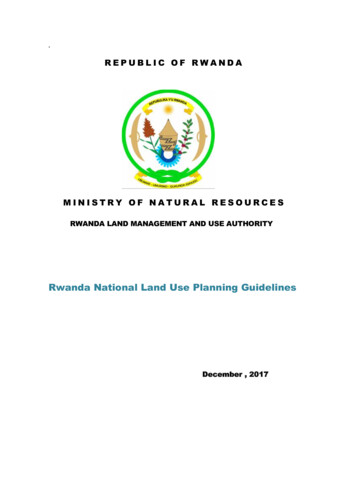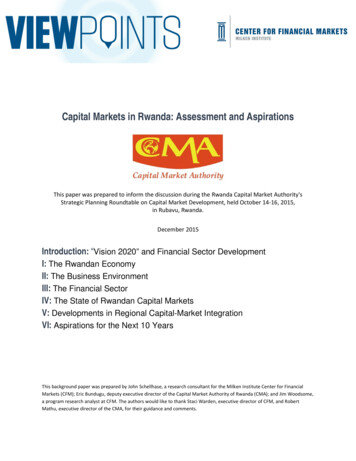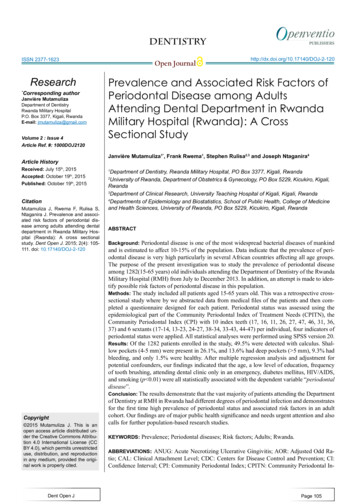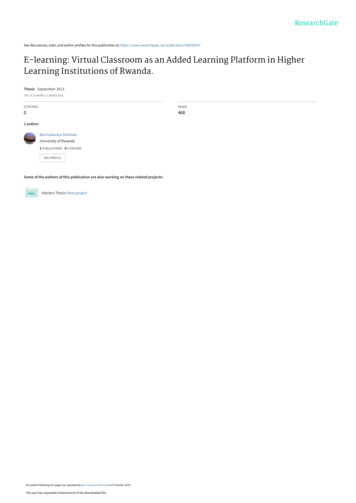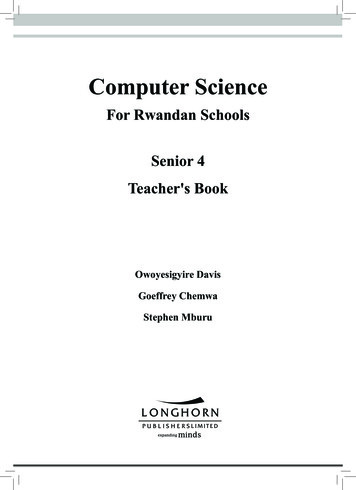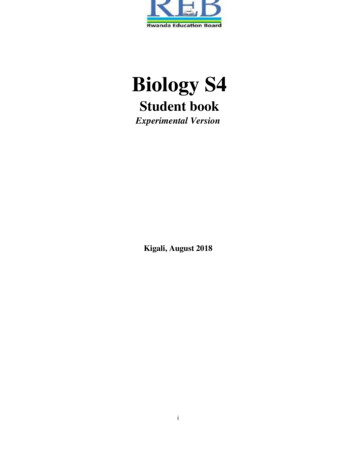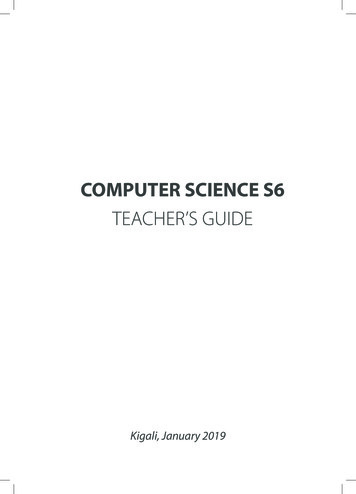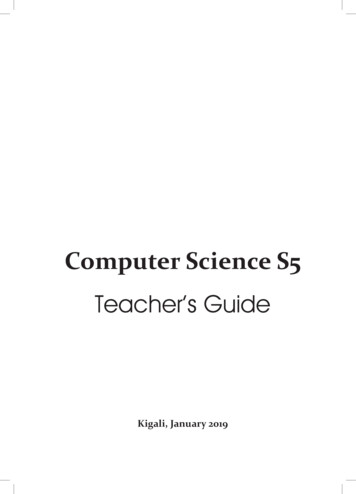
Transcription
Computer Science S5Teacher’s GuideKigali, January 2019
Copyright 2019 Rwanda Education BoardAll rights reserved.This book is the property of Rwanda Education BoardCredit should be given to REB when the source of this book is quoted.
FOREWORDDear teacher,Rwanda Education Board is honoured to present Senior 5 Computer Science teacher sguide which serves as a guide to competence-based teaching and learning to ensureconsistency and coherence in the learning of the computer science subject. TheRwandan educational philosophy is to ensure that learners achieve full potential atevery level of education which will prepare them to be well integrated in society andexploit employment opportunities.In line with efforts to improve the quality of education, the government of Rwandaemphasizes the importance of aligning teaching and learning materials with the syllabusto facilitate their learning process. Many factors influence what they learn, how wellthey learn and the competences they acquire. Those factors include the relevance ofthe specific content, the quality of teachers’ pedagogical approaches, the assessmentstrategies and the instructional materials available. Special attention was paid to theactivities that facilitate the learning process in which learners can develop ideas andmake new discoveries during concrete activities carried out individually or with peers.With the help of the teachers, learners will gain appropriate skills and be able to applywhat they have learnt in real life situations. Hence, they will be able to develop certainvalues and attitudes allowing them to make a difference not only to their own lives butalso to the nation.This is in contrast to traditional learning theories which view learning mainly as a processof acquiring knowledge from the more knowledgeable who is mostly the teacher. Incompetence-based curriculum, learning is considered as a process of active buildingand developing of knowledge and understanding, skills, values and attitudes by thelearner, where concepts are mainly introduced by an activity, situation or scenario thathelps the learner to construct knowledge, develop skills and acquire positive attitudesand values.In addition, such active learning engages learners in doing things and thinking aboutthe things they are doing. They are encouraged to bring their own real experiences andknowledge into the learning processes. In view of this, your role is to: Plan your lessons and prepare appropriate teaching materials. Organize group discussions for learners considering the importance of socialconstructivism suggesting that learning occurs more effectively when the learnerworks collaboratively with more knowledgeable and experienced people. Engage learners through active learning methods such as inquiry methods, groupdiscussions, research, investigative activities and group and individual work activities. Provide supervised opportunities for learners to develop different competences byTeachers’ Guideiii
giving tasks which enhance critical thinking, problem solving, research, creativityand innovation, communication and cooperation. Support and facilitate the learning process by valuing learners’ contributions in theclass activities. Guide learners towards the harmonization of their findings. Encourage individual, peer and group evaluation of the work done in the classroomand use appropriate competence-based assessment approaches and methods.To facilitate you in your teaching activities, the content of this teacher s guide is selfexplanatory so that you can easily use it. It is divided in 3 parts:The part 1: Explains the structure of this book and gives you methodological guidance;The part 2: Gives the sample lesson plans as reference for your lesson planning process;The part 3: Provides details the teaching guidance for each concept given in the studentbook.Even though this teacher s guide contains the answers for all activities given in thelearner’s book, you are requested to work through each question and activity beforejudging learner’s findings.I wish to sincerely appreciate all people who contributed towards the development ofthis teacher s guide, particularly REB staff who organized the whole process from itsinception. Special gratitude goes to the University of Rwanda which provided expertsin design and layout services, illustrations and image anti-plagiarism, lecturers andteachers who diligently worked to successful completion of this book. Any commentor contribution would be welcome for the improvement of this Teacher’s guide for thenext edition.Dr. NDAYAMBAJE IrénéeDirector General of REBivTeachers’ Guide
ACKNOWLEDGEMENTI wish to express my appreciation to all the people who played a major role indevelopment of this Computer science teacher’s book for senior five. It would nothave been successful without active participation of different education stakeholders.I owe gratitude to different Universities and schools in Rwanda that allowed their staffto work with REB in the in-house textbooks production project. I wish to extend mysincere gratitude to lecturers, teachers and all other individuals whose efforts in oneway or the other contributed to the success of writing of this textbook.Special acknowledgement goes to the University of Rwanda which provided experts indesign and layout services, illustrations and image anti-plagiarism.Finally, my word of gratitude goes to the Rwanda Education Board staff particularlythose from the Curriculum, Teaching and Learning Resources Department (CTLR) whowere involved in the whole process of in-house textbook writing.Joan MURUNGI,Head of Department CTLRTeachers’ Guidev
viTeachers’ Guide
ContentsFOREWORDACKNOWLEDGEMENTiiivPART I. GENERAL INTRODUCTIONxii1.0. About the teacher’s guidexii1.1. The structure of the guidexii1.2. Methodological guidancexiv1.2.1. Developing competencesxiv1.2.2. Attention to special educational needs and inclusive educationxvii1.2.3. Guidance on assessmentxix1.3. Guidance on assessmentxix1.3.1. Students’ learning styles and strategies to conduct teaching and learningprocessxix1.3.2. Teaching methods and techniques that promote the active learningxxPART II. SAMPLE LESSON PLANIII: UNIT DEVELOPMENTxxvxxviiiUnit 1: FUNDAMENTALOF LAPTOP AND PORTABLEDEVICES11.1.1.2.1.3.1.4.1.5.11113Key Unit CompetencePrerequisite knowledge and skillsCross-cutting issues to be addressedGuidance on the introductory activityList of lessonsUnit 2: DATA STRUCTURE AND ALGORITHM292.1.2.2.2.3.2.4.2.5.2929292930Key unit competencePrerequisite knowledge and skillsCross-cutting issues to be addressedGuidance on the introductory activityList of lessonsUNIT 3: INTRODUCTION TO COMPUTERNETWORK493.1. Key Unit Competence3.2. Prerequisite knowledge and skills4949Teachers’ Guidevii
3.3.3.4.3.5.3.6.Cross-cutting issues to be addressedGuidance on the introductory activityList of lessonsUnit summary49495164UNIT 4: INTRODUCTION TO 71717283848788Key Unit CompetencyPrerequisite knowledge and skills:Cross-cutting issues to be addressed:Guidance on the introductory activityList of lessons including assessmentUnit summaryAddition of informationEnd unit Assessment AnswerAdditional activityUNIT 5: DATABASE DESIGN935.1. Key unit competence5.2. Prerequisite/ Knowledge/skills5.3. Cross-Cutting Issues to be addressed5.4. Introductory Activity5.5. Lst of lessons5.6. Summary of the Unit5.7. Additional information5.8. Answers of End of unit1.2.1. Remedial activities and answers1.2.5. Consolidation activities and answers9393939394110110110112113UNIT 6: POINTERS AND STRUCTURES IN C 130130131viiiKey Unit CompetencePrerequisite knowledge and skillsCross-cutting issues to be addressedGuidance on the introductory activityList of lessonsSummary of the UnitAddition informationAnswers of End Unit Assessment answersTeachers’ Guide
6.9. Additional activities6.9.1. Remedial Activities6.9.2. Consolidation activities6.9.3. Extended133133134134UNIT 7: OBJECT ORIENTED PROGRAMMING IN C 1377.1. Key Unit Competence7.2. Prerequisite knowledge and skills7.3. Cross-cutting issues to be addressed7.4. Guidance on the introductory activity7.5. List of lessons (including assessment)7.6. Summary of the Unit7.7. Addition information for teachers7.8. End unit assessment answers7.9. Additional activities7.9.1. Remedial activities7.9.2. Consolidation activities7.9.3. Extended activities137137137137140160162162167167169171UNIT 8: INTRODUCTION TO VISUAL BASIC1758.1. Key Unit Competency:8.2. Prerequisite knowledge and skills:8.3. Cross-cutting issues to be addressed:8.4. Guidance on the introductory activity8.5. List of lessons8.6. Additional activities8.6.1. Remedial activities8.6.2. Consolidation activities175175175175176193193194UNIT 9: VARIABLES, OPERATORS, EXPRESSIONS ANDCONTROL 199200223225Key UnitCompetency:Prerequisite knowledge and skills:Cross-cutting issues to be addressed:Guidance on the introductory activityList of lessonsUnit summaryEnd unit assessment:Teachers’ Guideix
9.8. Additional activities9.8.1. Remedial Activities9.8.2. Consolidation activities9.8.2. Extended activities228228229230UNIT 10: INTRODUCTION TO JAVA23110.1. Key Unit Competency:10.2. Prerequisite knowledge and skills:10.3. Cross-cutting issues to be addressed10.4. Guidance on the introductory activity10.5. List of lessons10.6. Unit summary10.7. Addition information10.8. End unit assessment10.9. Additional activities10.9.1. Remedial Activities:10.9.2. Consolidation activities231231231231232245246248250250250UNIT 11: OOP AND JAVA25311.1. Key Unit Competence11.2. Prerequisite knowledge and skills11.3. Cross-cutting issues to be addressed:11.4. Guidance on the introductory activity11.5. List of lessons11.6. Summary of the unit11.7. Additional Information11.8. Aswers toend unit assessment11.9. Additional activities11.9.1. Remedial Activities11.9.2. Consolidation activities:11.9.3. Extended activities253253253253255269270271273273273275UNIT 12: IO AND JAVA27712.1.12.2.12.3.12.4.277277277277xKey unit competence:PrerequisiteCross-cutting issues to be addressed:Guidance on the introductory activity:Teachers’ Guide
12.5. List of lessons12.6. Unit summary12.7. Additional Information12.8. End unit assessment12.9. Additional activities12.9.1. Remedial Activities12.9.2. Consolidation activities12.9.3. Extended chers’ Guidexi
PART I. GENERAL INTRODUCTION1.0. About the teacher’s guideThis book is a teacher’s guide for computer science Senior Five in advanced level. Itis designed to help teachers in the implementation of competence based curriculumspecifically computer science syllabus.As suggested by its name, this is a guide that will help teachers in their daily preparationsof lessons. Teachers will take advice provided for in this book but are advised to bemore creative and consider their specific classes’ contexts and prepare accordingly.1.1. The structure of the guideThis section outlines the general structure whereby the content is organized in unitsand the sub-heading structure in order to provide to teachers more understanding ofthe different sections of this guide and what they should expect to find in each section. Overall structureThis consists of three main parts:v Part I: General Introduction.This part provides general guidance on how to develop the genericcompetences, how to integrate cross cutting issues, how take intoconsideration special educational needs, active methods and techniquesof teaching computer science and guidance on assessment.v Part II:Sample lesson planThis provides to teachers a model lesson plan that they can learn from individingtheir own lesson plans.v Part III:Unit developmentThis is the main part of the guide in which each unit is thoroughly developed. The guideends with references.Each unit is made of the following sections: Unit title: from the syllabus Key unit competence: from the syllabus Prerequisites (knowledge, skills, attitudes and values)The section indicates knowledge, skills and attitudes required for the successful carryingout of the unit. The competence-based approach requires connections between units/topics within asubject and interconnections between different subjects. The teacher will find anindication of those prerequisites and guidance on how to establish connections.xiiTeachers’ Guide
Cross-cutting issues to be addressedThis section suggests cross cutting issues that can be integrated depending on the unitcontent. It gives guidance on how to integrate those issues. The suggested issues areindicative and teachers are free to take any other cross-cutting issue which is related tothe learning environment. Guidance on the introductory activityEach unit begins with an introductory activity in the learner’s book. This section of theteacher’s guide provides guidance on how to conduct this activity and related answers.Learners are not expected to necessarily give right solutions but are invited to providepossible solutions or answers through discovery activities organized at the beginningof lessons or during the lesson. List of lessonsThe section of “list of lessons” provides a suggestion on the list of lessons, lessonobjectivescopied or adapted from the syllabus and duration for each lesson. Each lesson /subheading is then developed. End of each unitAt the end of each unit the teacher’s guide provides the following sections: Summary of the unit which provides the key points of content developed in thestudent’s book. Additional information which provides additional content compared to thestudent’s book for the teacher to have a deeper understanding of the topic. End unit assessment which provides the answers to questions of end unitassessment in the textbook and suggests additional questions and relatedanswers to assess the key unit competence. Additional activities: remedial, consolidation and extended activities). Thepurpose of these activities is to accommodate each learner (slow, average andgifted) based onend unit assessment results.Teachers’ Guidexiii
Structure of each sub headingEach lesson/sub-heading is made of the following sections:Lesson Sub heading title 1: . Prerequisites/Revision/Introduction:The section provides clear instruction to teachers on how to begin the lesson Teaching resourcesThis section provides suggestions on the teaching aid or other resources needed withactivities in order to achieve the learning objectives. Teachers have full ownershipof which teaching aid they can use depending on those available in their workingenvironment. Learning activitiesThis section provides a short description of the methodology and any important aspectto consider. It provides also answers to learning activities with cross reference to textbook: Exercises/application activitiesThis provides questions and answers for exercises/ application activities/1.2. Methodological guidance1.2.1. Developing competencesSince the introduction of the competency based curriculum for pre-primary, primaryand general secondary education in 2015 Rwanda shifted from to the knowledge basedsystem to new way of teaching and learning which put the learner at the canter. Inthis new approach teachers are not only responsible for the transfer of knowledge butalso for enhancing student’s learning achievement, and creating safe and supportivelearning environment. It implies also that a learners will have to show what they areable to do using the knowledge, skills, values and attitude acquired in a new or differentsituation.The competence-based curriculum approach bases teaching and learning on discreteskills rather than relying on only knowledge or the cognitive domain of learning. It putsan emphasis on what learners can do rather than what they know. Learners developbasic competences through specific subject unit competences with specific learningobjectives broken down into knowledge, skills and attitudes. These competences aredeveloped through learning activities disseminated in learner-centered rather than thetraditional didactic approach. The student is evaluated against set standards to achievebefore moving on.Adding to specific subject competences, learners also get an opportunity to developxivTeachers’ Guide
generic competences which are transferable throughout a range of learning areas andsituations in life. Below are examples of how generic competences can be developed inComputer Science:Generic competenceExamples of activities that develop generic competencesCritical thinking Compare the protected computer to the computerexposed to various security threatsResearch andProblem solving Demonstrate advantage of a computer network, havinga database in a school or an institution. Research using internet or books from the library Build a computer network by responding the initialrequest. Design and develop a website or an application softwarefor his/her school or institution.Innovation andcreativityCooperation,Personal andInterpersonalmanagement andlife skillsCommunication Demonstrate strategies that can be used to disinfect thecomputer or network attacked by threats. Translate the algorithms in a computing program Identify local computing problems and ways to resolvethem. Sharing resources on the network, emails Protecting his/her own data and school or institutiondata to. Work in Pairs Small group work Large group work Organise and present in writing and verbally a completeand clear report of their computing activities Develop accurate diagrams for networks topology,model Design with talking diagram a database of the school.Lifelong learning Select and use appropriate formats and presentations,such as tables, graphs and diagrams. Exploit all opportunities available to improve onknowledge and skills. Use open source technologies andother digital materials to keep informed.Among the changes in the competence based curriculum is the integration of crosscutting issues as an integral part of the teaching learning process-as they relate to andmust be considered within all subjects to be appropriately addressed. The eight crosscutting issues identified in the national curriculum framework are: genocide studies,Teachers’ Guidexv
environment and sustainability, gender, Comprehensive Sexuality Education (CSE),Peace and Values Education, Financial Education, standardization Culture and InclusiveEducation.Some cross cutting issues may seem specific to particular learning areas or subjects butthe teacher need to address all of them whenever an opportunity arises. In addition,learners should always be given an opportunity during the learning process to addressthese cross cutting issues both within and out of the classroom so as to progressivelydevelop related attitudes and values.Below are examples on how crosscutting issues can be addressed in Computer Science:Cross-cutting Examples on how to integrate the cross-cutting issueissueInclusiveeducationInvolve all learners in all activities without any bias.Eg: Allow a learner with physical disability (using wheelchair) totake notes or lead the team during computer lab activities. Student without arms can learn computer science using theirtoes.GenderPeace andValuesEducation Sign language can be used to address the need of studentswith hearing impairments. Involve both girls and boys in all activities: No activity isreserved only to girls or boys. Teachers should ensure equal participation of both girls andboys during computing activities as well as during cleaning andtidying up related activities after computer lab activities. During group activities, debates and presentations, the teacherwill encourage learners to help each other and to respectopinions of colleagues. Students must be warned about cyber security crimes andenabled to prevent hacking and stealing one’s data or preventunauthorised access of data of a person or institution.Standardizationculture Student must develop values of browsing relevant content onthe internet ( students should not spend their time browsingirrelevant and harmful content website. Students should be familiar with standards used in networktechnologies in their daily interaction with different tools usedin networking. For tasks involving calculations, they have to always presentaccurate results.xviTeachers’ Guide
FinancialEducation Student should develop this by comparing the use of digitaltechnologies with the traditional paper based practices. Eg. Compare the cost of sharing a 100 pages document on thenetwork of 50 users and printing 50 copies of 100 pages onindividual copy. Different technologies used in networking should be anopportunity to study cost implication of individual technology. Students do analysis of financial benefits of having a database. Students must be aware of loss that can be caused by lackingsecurity in computing.1.2.2. Attention to special educational needs and inclusive educationIn the classroom, students learn in different way depending to their learning pace,needs or any other special problem they might have. However, the teacher have theresponsibility to know how to adopt his/her methodologies and approaches in orderto meet the learning needs of each student in the classroom. Also teachers need tounderstand that student with special needs, have to be taught differently or need someaccommodations to enhance the learning environment. This will be done depending tothe subject and the nature of the lesson.In order to create a well-rounded learning atmosphere, teachers need to: Remember that students learn in different ways so they have to offer a varietyof activities (e.g. role-play, music and singing, word games and quizzes, andoutdoor activities) Maintain an organized classroom and limits distraction. This will help studentswith special needs to stay on track during lesson and follow instruction easily. Vary the pace of teaching to meet the needs of each students. Somestudents process information and learn more slowly than others; Break down instructions into smaller, manageable tasks. Students with specialneeds often have difficulty understanding long-winded or several instructionsat once. It is better to use simple, concrete sentences in order to facilitate themunderstand what you are asking; Use clear consistent language to explain the meaning (and demonstrate or showpictures) if you introduce new words or concepts; Make full use of facial expressions, gestures and body language; Pair a student who has a disability with a friend. Let them do things together andlearn from each other. Make sure the friend is not over protective. Both studentswill benefit from this strategy; Use multi-sensory strategies. As all students learn in different ways, it is importantto make every lesson as multi-sensory as possible. Learners with learningdisabilities might have difficulty in one area, while they might excel in another.For example, use both visual and auditory cues.Teachers’ Guidexvii
Below are general strategies related to each main category of disabilities and howto deal with every situation that may arise in the classroom. However, the list is notexhaustive because each student is unique with different needs and that should behandled differently.Strategy to help a learner with developmental impairment: Use simple words and sentences when giving instructions. Use real objects that students can feel and handle. Rather than just workingabstractly with pen and paper. Break a task down into small steps or learning objectives. The student shouldstart with an activity that s/he can do already before moving on to somethingthat is more difficult. Gradually give the student less help. Let the student work in the same group with those without disability.Strategy to help a student with visual impairment: Help students to use their other senses (hearing, touch, smell and taste) to playand carry out activities that will promote their learning and development. Use simple, clear and consistent language. Use tactile objects to help explain a concept. If the student has some sight, ask him/her what he/she can see. Make sure the student has a group of friends who are helpful and who allowhim/ her to be as independent as possible. Plan activities so that students work in pairs or groups whenever possibleStrategies to help a student with hearing disabilities or communication difficulties: Always get the student’s attention before you begin to speak. Encourage the student to look at your face. Use gestures, body language and facial expressions. Use pictures and objects as much as possible. Keep background noise to a minimum.Strategies to help a student with physical disabilities or mobility difficulties: Adapt activities so that students who use wheelchairs or other mobility aids,can participate. Ask parents/caregivers to assist with adapting furniture e.g. The height of atable may need to be changed to make it easier for a student to reach it or fittheir legs or wheelchair under. Get advice from parents or a health professional about assistive devices.xviiiTeachers’ Guide
1.2.3. Guidance on assessmentEach unit in the teacher’s guide provides additional activities to help learners achievethe key unit competence. Results from assessment inform the teacher which learnerneeds remedial, consolidation or extension activities. These activities are designedto cater for the needs of all categories of learners; slow, average and gifted learnersrespectively.1.3. Guidance on assessmentAssessment is an integral part of teaching and learning process. The main purposeof assessment is for improvement. Assessment for learning/ Continuous/ formativeassessment intends to improve learners’ learning and teacher’s teaching whereasassessment of learning/summative assessment intends to improve the entire school’sperformance and education system in general.Continuous/ formative assessmentIt is an ongoing process that arises out of interaction during teaching and learningprocess. It includes lesson evaluation and end of sub unit assessment. This formativeassessment should plays a big role in teaching and learning process. The teacher shouldencourage individual, peer and group evaluation of the work done in the classroom anduses appropriate competence-based assessment approaches and methods.In Senior Five computer science textbook, formative assessment principle is appliedthrough checking up activities that are planned in each lesson to ensure that lessonobjectives are achieved before moving on. At the end of each unit, the end unitassessment is formative when it is done to give information on the progress of studentsand from there decide what adjustments need to be done. Assessment standards aretaken into consideration when setting tasks.Summative assessmentThe assessment done at the end of the term, end of year, is considered as summative. Theteacher, school and parents are informed on the achievement of educational objectivesand think of improvement strategies. There is also end of level/ cycle assessment inform of national examinations.1.3.1. Students’ learning styles and strategies to conduct teaching and learning processThere are different teaching styles and techniques that should be catered for. Theselection of teaching method should be done with the greatest care and some ofthe factors to be considered are: the uniqueness of subjects; the type of lessons; theparticular learning objectives to be achieved; the allocated time to achieve the objective;instructional available materials; the physical/sitting arrangement of the classroom,individual students’ needs, abilities and learning styles.Teachers’ Guidexix
There are mainly four different learning styles as explained below:a. Active and reflective learnersActive learnerstend to retain and understand information best by doing somethingactive with it, discussing or applying it or explaining it to others. Reflective learnersprefer to think about it quietly first.b. Sensing and intuitive learnersSensing learners tend to like learning facts; intuitive learners often prefer discoveringpossibilities and relationships. Sensors often like solving problems by well-establishedmethods and dislike complications and surprises; intuitive learners like innovation anddislike repetition.c. Visual and verbal learnersVisual learners remember best what they see—pictures, diagrams, flow charts, timelines, films, demonstrations, etc.; verbal learners get more out of words—written andspoken explanations.d. Sequential and global learnersSequential learners tend to gain understanding in linear steps, with each step followinglogically from the previous one. Global learners tend to learn in large jumps, absorbingmaterial almost randomly without seeing connections, and then suddenly “getting it.”1.3.2. Teaching methods and techniques that promote the active learningThe different student learning styles mentioned above can be catered for, if theteacher uses active learning whereby learners are really engaged in the learningprocess.What is Active learning?Active learning is a pedagogical approach that engages students in doing thingsand thinking about what they are doing. In active learning, learners are encouraged to bring their own experience and knowledge into the learning process.The role of the teacher in active learning The teacher engages learners through active learning methods such as inquirymethods, group discussions, research, investigative activities and group andindividual work activities. He/she encourages individual, peer and group evaluation of the work done inthe classroom and uses appropriate competence-based assessment approachesxxTeachers’ Guide
and me
Rwanda Education Board is honoured to present Senior 5 Computer Science teacher s guide which serves as a guide to competence-based teaching and learning to ensure consistency and coherence in the learning of the computer science subject. The Rwandan educational philosophy is to ensure that learners achieve full potential at
